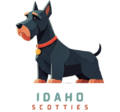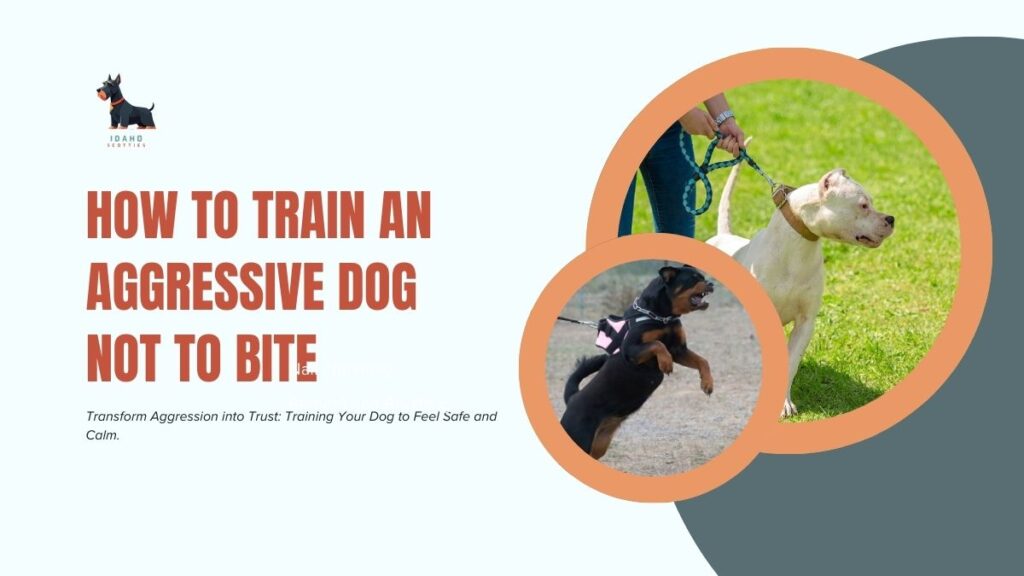Learn how to train an aggressive dog not to bite. This guide covers behavior management, positive reinforcement, and expert tips to ensure a safer, happier pet.
Controlling a biting and aggressive dog can feel like traversing through a tumultuous ocean, where calmness and control are essential to find safe shores. The American Kennel Club states that approximately 4.5 million dog bites are reported in the US each year.
That highlights the importance of dealing with such aggression at its core. But do not fret. By having the right strategies, understanding, and patience, it is possible to change the dog’s behavior.
Just like a wild stallion learns to trust its rider, so too could any undisciplined dog become an even-tempered companion with the right kind of help. Let’s take a closer look at how to tackle this problem and make it a success story!
How to Train An Aggressive Dog Not to Bite?
Is your dog’s aggressive behavior endangering you? Imagine your canine friend receiving strangers in a friendly manner instead of barking and snapping at them. It can be done with proper training! We need to discuss how we can transform their biting behavior and strengthen our relationship with them.
Understanding Dog Aggression

Comprehending Canine Aggression
Aggressive behavior in dogs is not about “bad” or “mean” behavior. More commonly than not, they stem from fear, insecurities, or other experiences. Identifying the origin of the issue is pivotal in resolving the aggressive behavior issue and assisting your dog.
Frequently Seen Reasons For Aggressive Behavior In Dogs
Fear: Canines tend to become aggressive if they feel threatened, frightened, or trapped.
Territorial Aggression: Certain canines are aggressive when there is an attempt to invade their territory or valuable resources, like a home or a yard.
Resource Guarding: Pets can growl or snap above a resting spot they feel like defending, a toy or food, which they feel the need to guard.
Pain Or Illness: If a dog is in pain, aggression can result from touching the painful areas.
Past Trauma: Abused and neglected dogs tend to become aggressive due to the need to protect themselves.
Identifying Triggers
It is crucial to identify the source of your dog’s aggression as it can be helpful in minimizing dangerous cases. Some of the most common triggers are:
Myth Buster: Aggressive Dogs Are Not Evil
Aggression is a response, not an aspect of a dog’s character. Most dogs, if properly guided and trained, can learn to cope better. Dogs are sometimes incorrectly labeled as “bad” or “ferocious” which inhibits their access to critical behavioral changes.
Safety First: Protecting Yourself and Others

One’s safety and that of the dog, and people around needs to be ensured before embarking on any sort of training. Everyone’s safety is guaranteed when taking steps towards correcting your dog’s behavior.
Actions to Avoid Incidents from Happening
Consider using a muzzle
Mules should be used when going out or meeting new people and pets to avoid unprovoked biting.
Avoid triggers
Avoid places or situations that have caused violent responses in the past until progress is made during training sessions.
Control the leash
Control and put your dog on a leash at all times, especially in new places or where danger is imagined, to avoid aggressive outbursts.
Monitor the interactions
You should never leave your dog unattended with children or guests, until you are bias enough to gauge their behavior.
Warning Signs
Most dogs will show signs of discomfort prior to aggression like stiffness and rigid blinking. Take heed of the below signs of aggression.
Stiffness in their posture
When the dog is alert, a sudden change to stiff form suggests that they have become rigid which is a sign they are tense.
Hackles raised
If the hair above the eyes raisers, the dog is feeling anxiety or has been petted.
Whale eye
Revealing the whites of the eyes is regarded as an indication of worry or nervousness.
Dogs employ different signals to communicate their true feelings. Such as snapping or growling, which indicates that you should leave them be.
Making use of lip licking or yawning
While this can be viewed as a sign of boredom or simply a common activity, it can also serve as an indicator of stress and discomfort during certain intense situations.
When to Seek Professional Help?

With the exception of certain extreme and unpredictable cases of aggression, most aggression issues can be addressed through training. However, there are times when dogs will need the assistance of a professional.
Red Flags that Require a Trainer or Behaviorist
Bites that break the skin
If your dog has bitten someone hard enough to cause injury, it is time for some steps that your veterinarian can assist with.
Extreme fear or panic-based aggression
Aggressive behavior triggered by an extreme level of fear, panic, or anxiety is a complicated issue that needs exterior intervention.
Aggression toward family members
f your dog displays aggressive tendencies towards other residents of the household, he may require professional help.
Unpredictable outbursts with no clear trigger
Randomized aggression, or hostility that seems sudden or unanticipated. May be more elaborately controlled with the help of a trainer or behaviorist.
Choosing the Right Trainer
Always remember that dogs can hurt other people too. Therefore, as with everything else, precise care has to be practiced when selecting the professional. Search for certifications and credentials that show expert knowledge in dog behavior. Some promising certificates include:
CPDT-KA (Certified Professional Dog Trainer – Knowledge Assessed)
This is a certification that a trainer is willing to vet for. It will assure you that the trainer has working knowledge of the behavior and training of dogs.
CAAB (Certified Applied Animal Behaviorist) focuses on complex behavior problems which require special training in animal behavior.
Veterinary Behaviorists
As an expert in animal behavior and medicine, these professionals are invaluable to your animal’s aggression problem that has a medical factor.
Step-by-Step Training Techniques

Fostering Growth Step-by-Step
The process of training your dog can be complicated and lengthy, but consistent work will help your pup feel more at ease in new surroundings and practice important behavioral skills.
Reward System
What should be addressed first is the overlying frame of aggression, as opposed to punishment. Every time your pup seems to ‘fight with another dog, simply reward the dilute excuse of aggression with a treat or praise.
This will cause your dog to ‘associate rewards with positive behavior, which is more desirable behavior ‘stimulates.
Dealing with Aggression ‘Desensitization & Counterconditionin
The aggressive triggers need to be slightly induced, while maintaining calmness. If your pet exhibits fear of strangers, start off by being calm when your dog and a stranger are brought close to one another, while using treats to reward positive behavior.
Gradually, you can help your dog build the much needed strength to demonstrate calmness around people who usually cause aggressive reactions.
Important Behavior Controls
“Leave it”: This helps you manage your dog’s aggressive behavior. This command helps dogs switch their focus from something that would elicit aggression to peaceful scenarios.
“Sit” & “Stay”: This command helps to ensure your dog’s calming and controlling behavior at times of stress or unpredictability.
Recall (“Come”): This could mean the difference between having complete control of your dog in public or from him/her becoming a runaway at a high-stress area.
Fixing Resource Guarding
To help with aggression over beloved items your dog may be clinging on (such as food or toys), try this.
Begin to put out a highly valued item to the dog for free and see what happens when they are playing with their favorite toy. You can also overserve when they are eating.
Little by Little, start to reward good behavior while approaching your dog to claim their position for food or toys.
Gradually build trust by claiming their most valued items and slowly return them back while showering the good boy/girl with praise or treats. Doing this will teach your dog that a human approaching them is not a threat.
But rather someone who provides rewards, slowly leading them to become comfortable with you.
Managing the Environment

Managing the Environment
There are many ways to mitigate aggressive tendencies of your dog and the first of which is placing him in a safe structured environment. This helps your dog feel more secure, and as a result, less aggressive.
Remove Triggers
Loud Noises: Drown out the thunderous activity of fireworks and the screaming of power tools with white noise machines or calm music to alleviate aggression brought on by those sounds. In addition, white noise machine and calming music fosters a cohesive around which your dog will feel at ease.
Unfamiliar Guests
Guests in your home can be a cause of aggressive activities. It is best to slowly introduce the stranger to your dog’s space with proper control measures in place. Start by getting the guest to stand some distance away to reward calm behavior.
Now gradually bring down the distance but only if the dog seems comfortable. This way, the dog gets used to people without feeling threatened.
Create a Safe Space
A safe spot is important for all dogs and especially those that are aggressive. Think of using a quiet room or a crate which the dog can run to when he feels like the going gets tough. The place should be able to nurture a calming atmosphere free of distractions. Soft bedding, a toy, and even an item of your scent can help the dog feel secure.
Try to Follow a Schedule
Keeping a dogs schedule allows them to feel more at ease, which lowers their stress levels. Make sure to feed, walk, and train your dog at the same time each day. This not only helps your dog remain calm, but also makes him feel protected because he knows what will happen during the day.
Changing their environment can evoke anxiety which can lead to aggression, so try to keep things constant.
Long-Term Strategies for Success

Achieving results that actually last requires a fair share of time, patience, and consistency. With the right efforts, your dog will learn to better control their aggressiveness and eventually behave in a calmer, more balanced manner.
With that said, it’s entirely achievable as I’m positive that your dog can improve their aggressive behavior in time, but here’s what you should know:
Patience is Key
It’s as straightforward as it gets, every dog is unique, and some take more time than others to overcome aggression. Patience is necessary for change to actually happen so by celebrating small moments of peace, you’re positively contributing to the situation.
Remember, the small changes you make along the way are all positive milestones so don’t get impatient. Instead retain confidence, motivate yourself to stay consistent in your initial approach, and your dog will change over time.
Controlled Socialization
Socialization forms an important pillar in helping alleviate aggression that stems towards other people or animals, and it is crucial that pets are gradually introduced to other pets and new people.
What’s equally as important to point out in that context is that socialization should never be forced as it leads to increase in anxiety and stress, which might further boost aggression.
So instead, as the person guiding the process, reward aggressive behavior that calms down in tense situations.
This helps your pet adjust at her own pace while at the same time, bringing it down during aggressive stimulations, and teaches her to adjust in a socially acceptable manner.
Exercise & Mental Stimulation
Dogs can get a lot of benefit out of exercising. It helps with aggression and is helpful for their overall health. Going on walks, having playtime, or letting them roam free in a safe place will also help keep your dog sated. Don’t forget about mind exercises as well.
The use of puzzle toys, scent games, and other forms of interaction can stimulate your dog’s mind while keeping them engaged and reducing their frustration. A mentally stimulated dog is less likely to be aggressive or anxious.
What NOT to Do?

When tackling aggression in dogs, knowing what does not work or what to avoid is equally important. Refraining from these practices can prevent making the situation worse.
❌ Do Not Use Dominance Based Training
Dominance techniques, which involve alpha rolls, severe corrections, or intimidation, are old-fashioned and worsen aggression. These practices amplify fear and anxiety, which are in true contradiction of feeling secure.
When dogs sense danger and panic, they will utilize any means necessary to fend off the fear inducing threat. Instead of utilizing practices that assert one’s authority, positive reinforcement and trust must be the focus.
❌ Interactions Should Never Be Compulsory
Instilling a sense of dread in dogs can lead to aggression, thus keeping them in encounters where they physically or mentally feel uncomfortable will only worsen their aggression.
Whether it’s forcing your dog to meet people, straining them in confined spaces, or pushing them against other dogs, all of these only build dread.
Allow your dog to handle people or new environments as they prefer, and make sure that calm behavior is always praised. Control lives breeds a sense of safety for a dog, giving them autonomy over when and how they interact.
❌ Skip Aversive Tools
Shock collars, choke chains, and prong collars may put your dog under immediate control but create more pain-induced aggression later. While they may seem effective in the short-run, trust me, these devices are inflicting pain that only heightens anxieties and stress levels.
Such conditions can provoke aggressive behavior instead of solving the root problem. Shift your attention towards more kinder approaches that are aimed at correcting and use positive reinforcement instead.
Real-Life Success Story
Meet Max, a three-year old rescue dog whose food aggression made life very difficult for Max and his new owner, Sarah. In the beginning, Max would snap and growl at anyone he interacted with and whenever either of them tried to approach him during meal time made it rather difficult.
In an attempt to help Max with his fear-based aggression, Sarah hired the help of a professional trainer who focused on positive reinforcement and desensitization.
At first, Sarah started off by sitting close to Max during meal times and tossing treats towards him, this later on helped in forming a positive approach so that she was not a threat in his eyes.
Later on, Sarah was able to inch closer towards Max while also rewarding him for his calm behavior. Eventually, Sarah was able to start touching Max’s food bowl and replacing it with a clean one, containing better food as a reward.
After a few months, Max was able to learn that humans were not a threat and he was able to remove his growl from his behavioral system. Max’s overall behaviour improved significantly.
Today, Max is a much calmer and happy dog to which proves that aggressive behavior can be transformed with the right teaching along with patienc, belief and consistency.
Conclusion
Having a dog which has aggressive tendencies towards biting means you have to have a lot of patience, be consistent, and understand your furry friend’s needs if you wish to train him out of that habit.
To address the aggression, you need to begin by determining why your dog is aggressive and what the warning signs are, Then, these signs can be used to address the issue in a safe and effective manner.
While building trust between you and your pet, you can use positive reinforcement alongside desensitization and controlled socialization to help your pet learn to trust you while replacing unsafe behaviors with safer ones.
Another way to help is by creating structure, controlling the triggers that may instigate the aggression, managing their mental stimulation, and making sure physical activities are done regularly. I
f the aggression is exceptionally strong and unpredictable, you should consider hiring a certified trainer or behaviorist who is in a better position to take control of the wrath to ensure your pet’s safety.
Even though it requires a lot of time and effort, the end game is a calm, happy pet. Using the correct method every time and being patient every time, can ensure an unwavering bond between you and the pet while eliminating any aggressive behavior that your pet might have.
Pet trainer with a passion for helping animals and owners build strong, loving bonds through positive reinforcement and expert care.


